Related sites:
Newsletter: Perspectives on Power Platform
Company: Niiranen Advisory Oy

 A significant share of Dynamics CRM systems tend to be implemented for B2B sales scenarios. In the age of social selling, digging up information about the person you’re about to call will quite often involve looking up his or her LinkedIn profile. With this in mind, surely everyone’s running a tight integration between their customer relationship management system and the LinkedIn network, right? Well, based on my personal experience, quite often it tends to be one of those requirements that come up during the sales phase but then get phased out from the actual go-live of a new CRM system.
A significant share of Dynamics CRM systems tend to be implemented for B2B sales scenarios. In the age of social selling, digging up information about the person you’re about to call will quite often involve looking up his or her LinkedIn profile. With this in mind, surely everyone’s running a tight integration between their customer relationship management system and the LinkedIn network, right? Well, based on my personal experience, quite often it tends to be one of those requirements that come up during the sales phase but then get phased out from the actual go-live of a new CRM system.
The question of “how to integrate Microsoft Dynamics CRM with LinkedIn” has been making the rounds in various forums for as long as I’ve been involved with the product. Now that you’ve potentially arrived here in search for an answer (thanks, Google!), I thought I’d collect a few pieces of information and personal thoughts on the subject. If you have any experiences to share regarding using Dynamics CRM in the social selling scenarios, please do leave a comment in the box below.
As always with information systems, there’s integration and then there’s “integration”. If you can meet the requirement by just surfacing a bit of content from LinkedIn inside a Dynamics CRM form, then here’s a great article from Salesmetrix that shows you the steps to integrate the LinkedIn Member Profile badge onto a CRM contact form. By adding a simple web resource and signing up for a LinkedIn API key you can show the contact’s job title and picture from LinkedIn alongside your CRM data, like this:

Why is this not the perfect solution? Well, did you notice the step require for copy-pasting the URL to the contact’s LinkedIn profile field before the profile badge is shown? Yeah, that’s the bit that your sales people are most likely not going to perform. Getting them to even enter the minimum required details on their leads and opportunities into a CRM system can be a major struggle, so introducing a complex operation like this into the process is going to require plenty of sales skills from the implementation consultant to convince the users that there’s a tangible benefit for them in filling in all the blanks on the contact form.
That’s of course not anything that couldn’t be overcome with a little bit of further development. One example for performing the profile search dynamically based on name fields on the CRM records can be found from Nicolae Tarla’s blog. Coincidentally, Nicolae has also recently released the Microsoft Dynamics CRM 2011 Scripting Cookbook that contains a few examples of lightweight social network integrations in the final chapter. Building proper social profile discovery services will require more than mere Javascript, but for showing LinkedIn Member Profile Plugin and Company Insider Plugin in the CRM UI you probably don’t need to invest a whole lot of time in developing a working solution.
You could choose an even more simplified approach and just add a button on the contact form’s ribbon to open LinkedIn search page with pre-filled values. A URL like http://www.linkedin.com/vsearch/p?firstName=Jukka&lastName=Niiranen&company=CodeBakers will get you onto my LinkedIn profile faster than manually entering the same search terms. You can study the LinkedIn URL Query Parameters to see the kinds of variables that could be used. There’s also a post on the old CRM Online Team blog that shows you how the button would have been added back in the CRM 4.0 days. (While building your URL’s, do remember to handle special characters and spaces in contact and account names.)
The problem with all these type of solutions is that if you’re not paying for them (on a continuous basis), you can’t expect them to remain working forever. Several variations of the LinkedIn and Dynamics CRM integration techniques have come and gone, such as Marco Amoedo’s CRM 4.0 LinkedIn Company Insider Widget hover link and Leon Tribe’s & Matt Wittemann’s Five-Minute Integration Between Dynamics CRM and LinkedIn. All fine solutions in their time, but as the API’s and applications keep changing, the need for re-developing solutions to the same problem remains.
A company like LinkedIn surely wouldn’t have missed the chance for monetizing the data they’ve accumulated into their network by selling it to B2B sales people who are using a system like Microsoft Dynamics CRM, now would they? Of course not, which means “there’s an app for that”: LinkedIn for Microsoft Dynamics CRM.
The product requires a Sales Plus or Sales Executive subscription for LinkedIn, which start from €28.95 per user per month. If you’re like me, you probably receive frequent “special offers” for a free month of LinkedIn Premium. This time I decided to activate the offer and use it for test driving the Dynamics CRM solution. The deployment process was quite straightforward for a CRM Online environment as no further configuration was needed apart from installing the solution file. After that, this is how you’ll see LinkedIn company profile and people data on the account form:
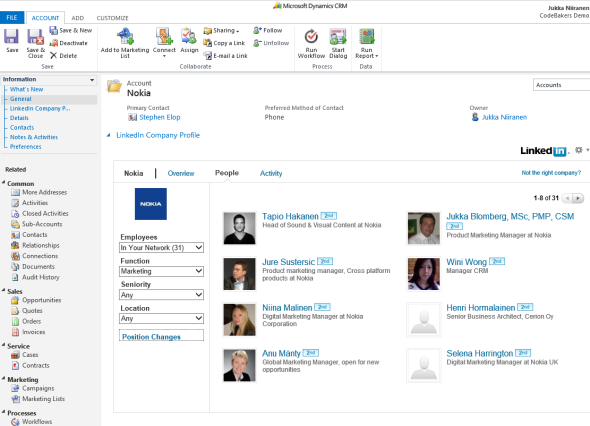
On the contact form we have tabs for both Company Profile and individual Member Profile.
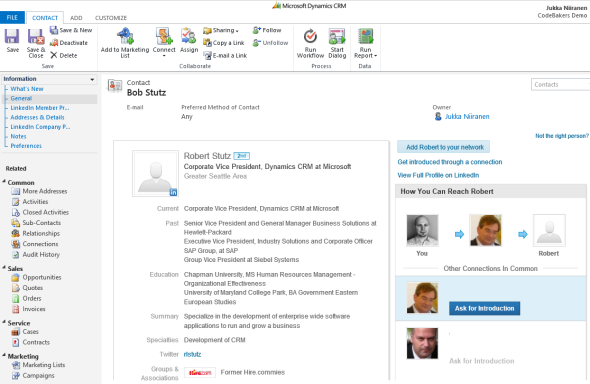
For some reason the lead form doesn’t get any LinkedIn components added on it, so you’ll need to qualify the lead to an account and contact before being able to leverage the integration.
Not every CRM user needs to have the subscription, but unless they do, they’ll not be able to see the premium content on the account or contact forms. Therefore you’ll probably need to manage role based forms for different user groups by creating a specific LinkedIn security role for those who have the Sales Plus subscription.
Unfortunately the solution from LinkedIn hasn’t yet been updated to be compatible with the cross-browser world of Polaris / Update Rollup 12, so using it on Chrome, Firefox or Safari isn’t supported. Also Internet Explorer 10 fails to render any content in the iFrame and LinkedIn recommends downgrading to IE9, so if you’re running Windows 8 you’ll need to run Dynamics CRM in IE7 Compatibility View to make use of the solution. No release schedules for an updated solutions were available when I asked about this from LinkedIn support. Needless to say, running CRM Online with the new Polaris process forms isn’t supported with the LinkedIn add-on.
What if we are really determined to get the most out of this wonderful source of “free” information that is LinkedIn? Wouldn’t we want to pour all the data into our own CRM database and preferably also synchronize it with the latest updates available from different online directories?
The LinkedIn solution for Microsoft Dynamics CRM doesn’t allow you to physically retrieve any data from LinkedIn into the CRM database. It’s all just a UI level integration that presents the additional details in an iFrame. Why do they stop there? Well, the answer is quite simple: LinkedIn is all about the user profile data and they don’t want you to simply just retrieve this into your own database and skip their service altogether in the process. The terms of the LinkedIn API are quite clear about this:
“The first rule of LinkedIn API is: You do not store data from LinkedIn. The second rule of LinkedIn API is: You do not store any data you receive from LinkedIn, except for the member ID.”
Surely many companies have tempted with the idea of breaking the rules, but nothing good has ever come from such foolish attempts. There are no free lunches, even in a seemingly free service, so just don’t go there.
There is of course a variety of B2B database service providers out there whose business model has been designed specifically for selling contact details to companies wishing to upload them into their own CRM systems. You’ll likely find such services from your local markets and they may even have a solution available for Dynamics CRM integration.
As an example, the solution from InsideView does allow you to import new contacts or leads as well as synchronize the existing records with updated information from their database, assuming you are connected on LinkedIn.

Oh, and it works on Polaris forms and cross-browser, too:
If you’re serious about enabling your sales team with the latest & greatest in social selling tools, then investing in a service like this is probably a good idea. Just ensure that the data you get from them covers the actual markets where you need to be reaching the contacts in.
Now that Microsoft has acquired companies focusing on social technologies, namely Yammer and NetBreeze, can we expect a LinkedIn integration to be included in a future release of Microsoft Dynamics CRM? Recently we’ve already seen the new Office 365 address books in the Exchange Online 2013 version gain a “connect your networks” feature:
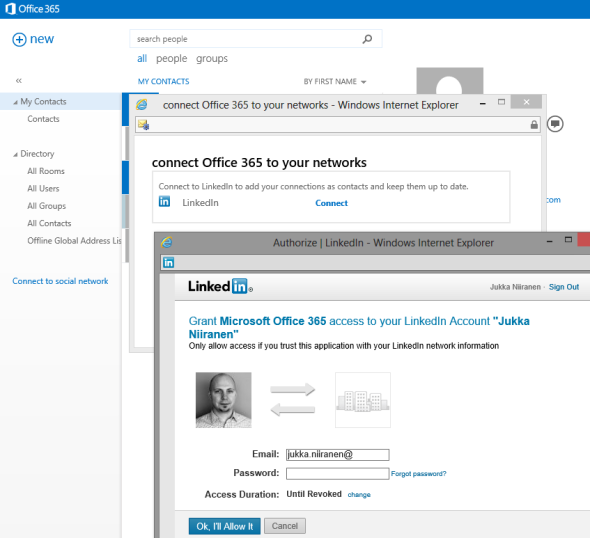
However, this is more in the territory of Outlook Social Connector or the LinkedIn account sync found on every Windows Phone. It’s all just personal address books rather than a corporate CRM database, which means that different rules apply to it. Therefore you shouldn’t expect such a feature to find its way into a product like Dynamics CRM. Of course if the Outlook client integration would be leveraged for tracking the data into CRM contacts then that’s another story, but it’s still all user decisions rather than a central synchronization machine.
So what else is out there? Solutions like Webfortis Parrot already offer the possibility of promoting items from LinkedIn feeds into records in CRM (see this review by Gareth Tucker for details) and there’s a free edition for 2 user licenses available for you to experiment with. While this offers a nice set of tools for anyone tasked with monitoring the social streams for content worth tracking, it’s unlikely to cater for the same audience that is interested in searching decision makers and influencers from LinkedIn.
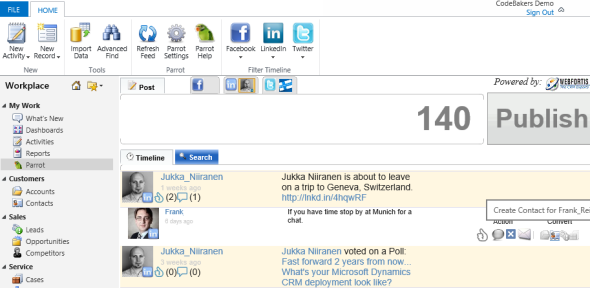
NetBreeze, once integrated into Dynamics CRM, will probably offer a nice set of listening capabilities for various social channels. Whether these tools will reach beyond the marketing department’s territory is another question. At least Bob Stutz has promised to build social right into the product, bringing it “just there” rather than an add-on service, so let’s hope there will be functionality to support the sales scenarios as well.
Out of curiosity, I checked out how the Customer Company performs on the social front. Salesforce.com offers a feature called Social Accounts, Contacts, and Leads, which “lets you view social network profiles and other social information for your accounts, contacts, and leads, directly in Salesforce.” LinkedIn is included as one of the networks there, but curiously it’s only supported for contacts, leads and “person accounts”, meaning there’s no company profile information available. Nevermind, let’s try it out in practice.
Contact records in Salesforce have a bunch of social network icons below their name and clicking on the LinkedIn logo gives the prompt below. Unfortunately the “tell me more” link is dead, so we can’t learn much about the feature without authorizing the app to use our LinkedIn account. Guess we’ll need to proceed anyway.
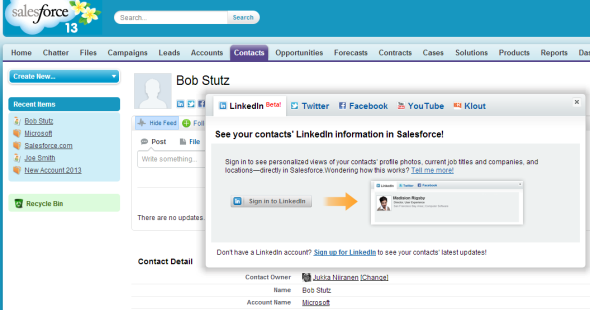
Once authorized, we can find a selection of matching profiles to choose from. After clicking on the right one, we have connected the contact in our CRM with a profile in LinkedIn. Great! Except that we don’t really get much else out of it. You see, Salesforce also requires the purchase of a LinkedIn Sales Plus or Sales Executive subscription to see any information inside CRM. Without it, all you can see is the job title of the person as record in their member profile, as well as the profile picture if available.
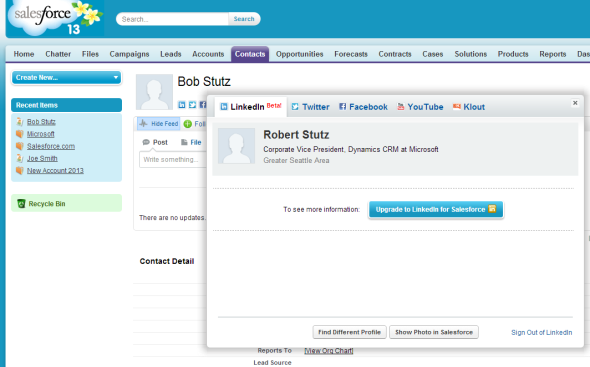
What’s really the cruel part is that there’s not even a link to open the connected profile on the LinkedIn site, even though the data obviously exists in the CRM database now. Therefore, if you wish to enable your sales team with the social network intelligence tools right inside your CRM application, you’ll have to purchase the same additional subscription as with Microsoft Dynamics CRM. The Salesforce social profiles feature looks actually just like a built-in ad for the LinkedIn for Salesforce premium product.
The Twitter and Facebook profile lookups are functional without an extra subscription. While this does speed up finding the right social network profile, you won’t necessarily find much B2B content from here. Of course it’s nice to be able to see the persons tweets inline on the contact form, but you can’t convert these into any type of records inside your CRM database with this basic service. Presumably you’ll need Social Marketing Cloud (a.k.a. Radian6) subscription for that.
Then, finally, there’s the disclaimer:
“The Social Accounts and Contacts feature uses Facebook, Klout, LinkedIn, Twitter, and YouTube public APIs to display social information in Salesforce. Because these social networks have the option of modifying or terminating access to their APIs at any time, salesforce.com can’t guarantee the future availability of this feature or any of its functionality, including access to the data that is currently provided or to any particular social network as a whole.”
Therein lies the problem of course. These are external services that exist in their current form for the time being, no further guarantees. Twitter in particular has been known for imposing new restrictions on their API and effectively killing most of the developer ecosystem in the process while searching for a business model. Thinking of Klout, do you imagine it will be around long enough to warrant making it an integrated part of your CRM suite?
Hi Jukka. This will come off as self-promotional, but we addressed this challenge in our cafe moba for Microsoft Dynamics tablet app. LinkedIn profiles (or at least a search for LinkedIn profiles in the case of multiple hits on a single name) are dynamically linked to your Dynamics CRM (Online) contacts. Because we enable you to sign into LinkedIn through the app, you would be able to see profile information according to the license you have.
The app is available in both the Windows Store for Windows 8 and the App Store for iPad, and, if you’re really diligent, you can find us on Pinpoint (Pinpoint hasn’t really caught up to the whole mobile thing…). It is free, and comes out-of-the-box with the LinkedIn integration. We can also connect other social media sources including Twitter, Facebook, and Google +, but these aren’t available in the free edition.
And, if you’re still with me, we also have a Salesforce edition (App Store for iPad only) that also features the LinkedIn integration.
Cheers Jukka, I followed your link and found that InsideView are currently offering a free trial, nothing to lose in giving it a shot.
[…] See on niiranen.eu […]
The upcoming release from ClickDimensions looks interesting in terms of showing social profiles for leads and contacts in CRM. Integrating with the FullContact API should provide a bit more robust functionality than the profile discovery in CD’s previous versions. http://blog.clickdimensions.com/2013/06/clickdimensions-feature-sneak-preview-social-profiles-enhanced-with-data-from-fullcontact.html
[…] LinkedIn, Dynamics CRM and Social Selling By: Jukka Niiranen (@jukkan) These days all CRM is social, and all selling is social. Jukka touches on the frequent lack of integration between CRM and social networks like LinkedIn, which inhibits the productivity of salespeople. Without a standardized method for fully integrating LinkedIn with CRM, many companies don’t take advantage of the benefits that come with a deeper customer profile possible using LinkedIn data, and Jukka goes through various methods for integrating Microsoft Dynamics CRM and LinkedIn. Methods range from integrating the LinkedIn Member Profile badge onto a CRM contact form, to utilizing the “LinkedIn for Microsoft Dynamics CRM” app, to getting around LinkedIn’s API rules to fully integrate their data into your system. […]
An updated version 2.0 of the LinkedIn Sales Navigator solution for Microsoft Dynamics CRM has been released now: http://sales.linkedin.com/blog/be-more-productive-with-sales-navigator-and-microsoft-dynamics-crm/
[…] ways of integrating information from LinkedIn into your CRM which are well-covered in this article from Surviving CRM, though we haven’t tested them ourselves, so please use your own judgement before implementing […]
[…] It hasn’t happened yet. What we’ve seen so far on the Dynamics 365 side has been mostly just the Microsoft Relationship Sales offering that embeds content from LinkedIn into the UI of Dynamics. Sure, there’s a bit more to it on the functional side, but it still closelt resembles the LinkedIn Sales Navigator that Paul Greenberg has always hated, calling it “a faux middleware to get access to the LinkedIn data”. In the standard Dynamics 365 Sales Enterprise app, there still isn’t even a LinkedIn profile card available yet for contacts, whereas Outlook on the web shows one. All in all we’re still surprisingly close to what the social selling story for Dynamics CRM was back in 2013. […]